Many people often use the words kayak and canoe interchangeably. However, they are very much different vessels and sports. If you are unfamiliar with what makes a kayak and canoe different, then you will be glad to know that we have everything you need to know to tell the difference between kayaks and canoes.
The biggest difference between a kayak and a canoe is that canoes have an open deck and are paddled with a single-bladed paddle, while kayaks have a more enclosed deck, and a double-bladed paddle is used to propel them through the water.
Although these are both recreational boats, the kayak and canoe are significantly different and serve different functions. When you love the water and the water activities that come along with it, then a canoe or kayak will come in handy.
While the canoe is used mainly for recreational purposes and traveling across water, the kayak is designed for more activities involving more thrill. The kayak and canoe shape is also different, but besides the obvious, there are a few things to know about the difference between kayak and canoe. Before we get into the difference between a kayak and a canoe, it is important to know what kayaks and canoes are.
What Is A Kayak?
A kayak is a small paddle-driven watercraft. They are sleek in design and lie close to the water’s surface. Kayakers paddle sitting down with their legs stretched out in front of them, either inside the closed hull or on top of the kayak in the case of sit-on kayaks. Kayaks are paddled using a double-ended paddle that allows for more control and rapid movement. Sit-inside kayaks can be sealed closed with a spray skirt that will stop water from entering the vessel and allow them to be used in more challenging water.
Historically, kayaks originate from the native people of the northern circumpolar region, including Alaska, Northern Canada, Greenland, and parts of Siberia. They were originally made from driftwood, animal bones, and skin and were used as tools for hunting.
Today, many types of kayaks are available, including inflatable kayaks, and they all have varying purposes.
What Is A Canoe
A canoe is also a man-powered paddle-driven craft, hence the common confusion. However, canoes have open decks, allowing their occupants to move more freely. A canoe paddler also is normally kneeling or sitting on an elevated seat and paddles with a single-bladed paddle.
Canoes also generally are paddled by multiple people and can carry more cargo. This makes them very popular with families who want to enjoy the water together.
Their simple design means that it is hard to pinpoint exactly who invented the canoe. Still, we do know that many of the pacific islands were colonized by Polynesians using outrigger canoes.
The Difference Between Kayak and Canoe
Although there are obvious differences between kayaks and canoes, the kayak will usually use a double-ended paddle with a paddler that is sitting. The kayak is considered stable and very comfortable.
With the canoe, the paddler uses a single-bladed paddle, and the individual will be kneeling or in a sitting position. A canoe is also an open-decked vessel, unlike a kayak which often has a closed deck.
The Position of the Paddler
The position of the paddler is a distinct difference between the kayak and canoe. Kayaks are usually paddled by a single person sitting in the middle, while canoes are usually paddled by multiple paddlers that are spread out along the length of the canoe.
This in itself is not enough to distinguish a kayak from a canoe, as single-person canoes and tandem kayaks do exist. It is the seated position with the legs extended forwards that makes it a kayak rather than a canoe.
- In the canoe, an individual can kneel or sit as they paddle. When canoeing solo, it may be more comfortable to be sitting.
- The position of the kayak paddler is always in a sitting position on or inside the hull of the kayak and has their legs out in front of them.
Types of Canoes and Kayaks and their Uses
When you plan to use a canoe or kayak, it is important to know that there are several types to choose from and that they come in many different designs and sizes that are perfect for various water conditions. We’ve listed a few canoes and kayaks currently available and the places to use them the best.
Canoe Types
The Whitewater Canoe
The whitewater canoe is a shorter version of the recreational canoe, which has a higher freeboard and more rocker. This means it has higher sides and more of a curve from bow to stern. These features help to limit the amount of water that comes into the canoe in white water. They are also more maneuverable when on whitewater and can be controlled by a couple of paddlers or solo.
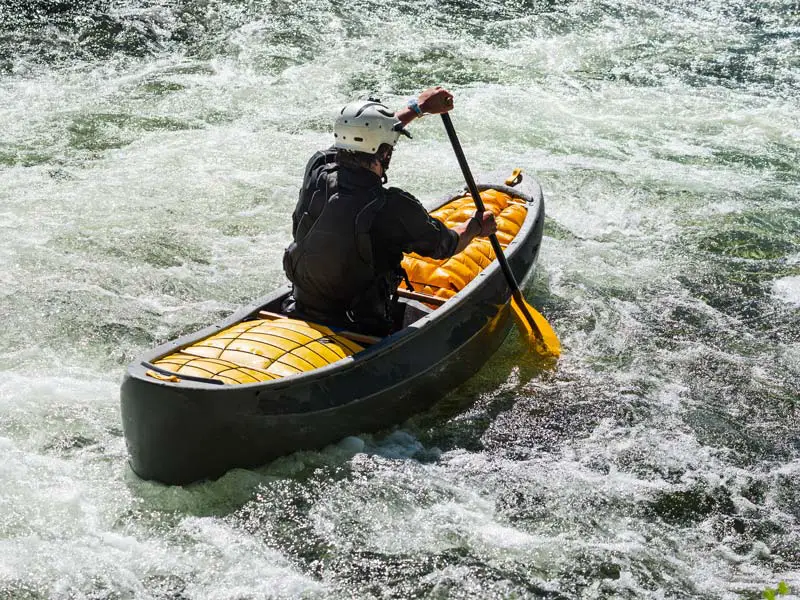
The Recreational Canoe
This canoe type has a length that can stretch to 17 feet and can include several people. It is a very stable boat and can be controlled easily. It is best suited for water that is smooth or slow-flowing. A lake or slow-moving river is the best spot for this type of canoe. Recreational canoes are also suited for carrying more cargo which makes them popular for camping or fishing trips.
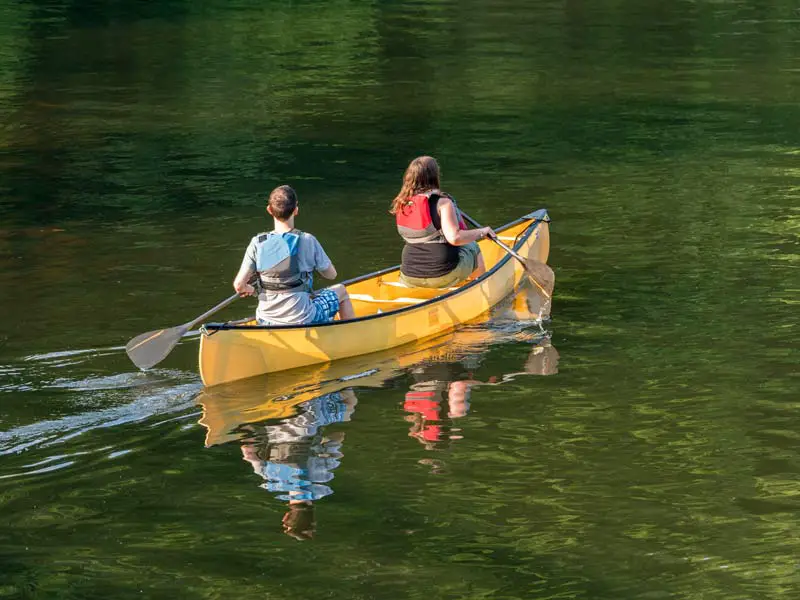
The Racing Canoe
This canoe is narrow and low and permits a paddler to be near the water’s surface. It accommodates a maximum of two paddlers for racing. Due to its racing capabilities, the need for speed is accomplished by either half-sitting or half-kneeling to achieve the most power and speed.
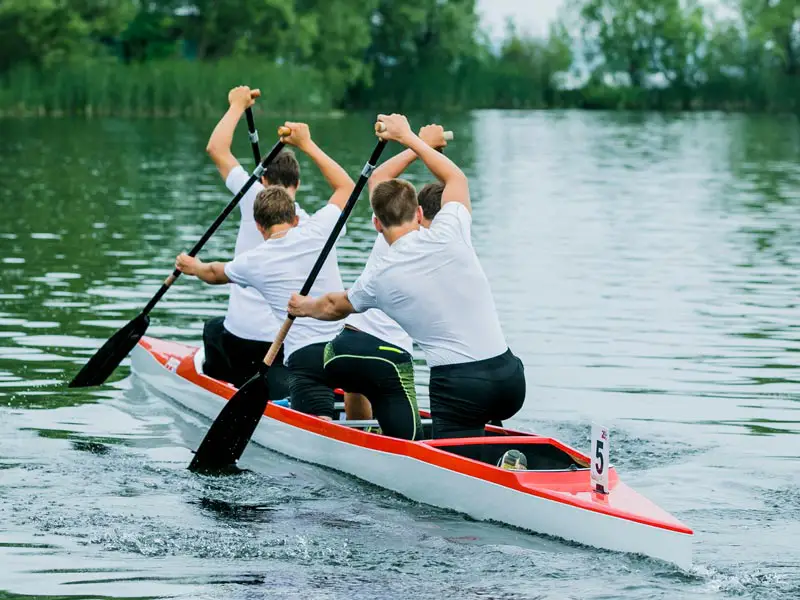
The Outrigger Canoe
Outrigger canoes are ocean-going canoes that feature a sponson off the side of the main hull; this is the “outrigger.” The outrigger is made from logs or floats and is there to stop the canoe from capsizing in ocean waves. These canoes are popular craft in the Pacific Islands and are used in racing.
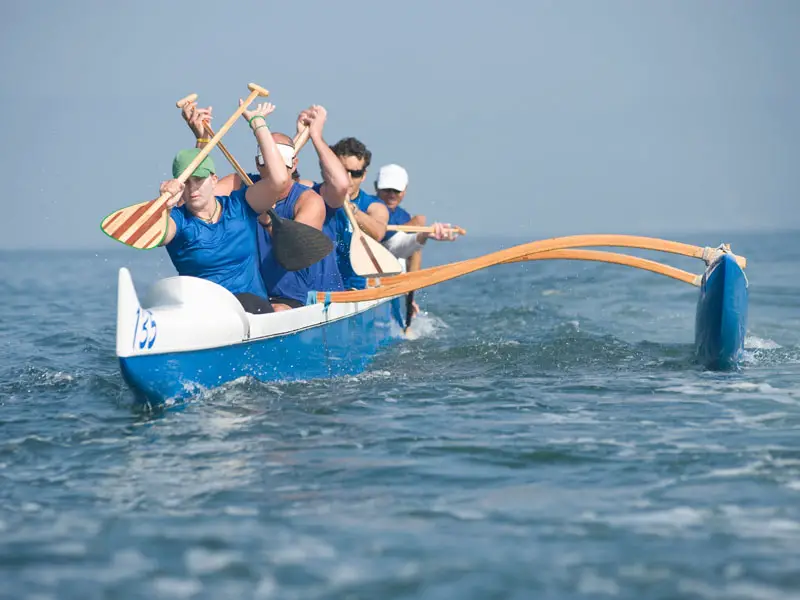
Kayak Types
The Sea and Touring Kayak
This kayak is capable of reaching 18 feet and is designed for speed because of its narrow length. There is more space in watertight bulkheads so that more gear can be taken on tours. The watertight bulkheads also prevent the kayak from sinking if it tips over. Some sea kayaks also feature a rudder that may be controlled by the paddler’s feet to assist with steering.
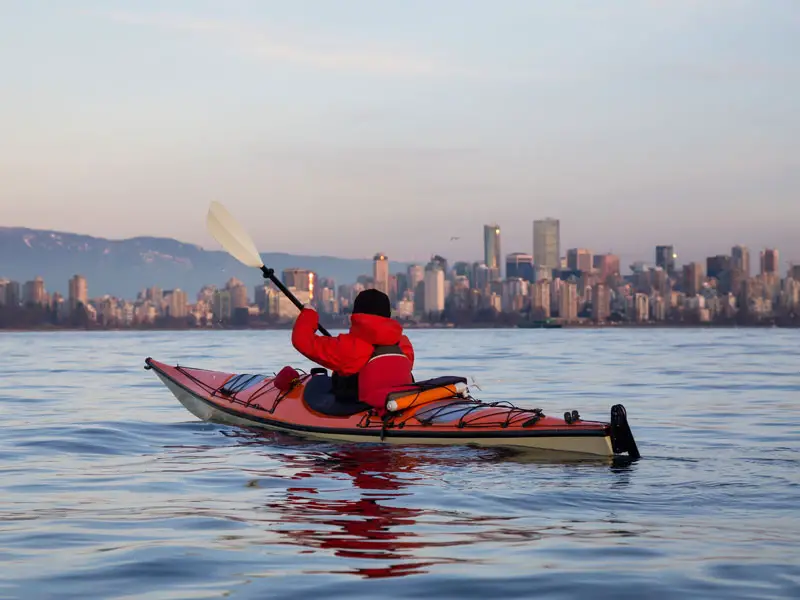
Whitewater Kayak
Whitewater kayaks are shorter and more maneuverable than other kayaks, varying in length between 6 and 9 feet. They are wider and have This kayak’s length also varies and can reach 9 feet. This type of kayak has a huge amount of buoyancy and allows it to respond perfectly to whitewater conditions.
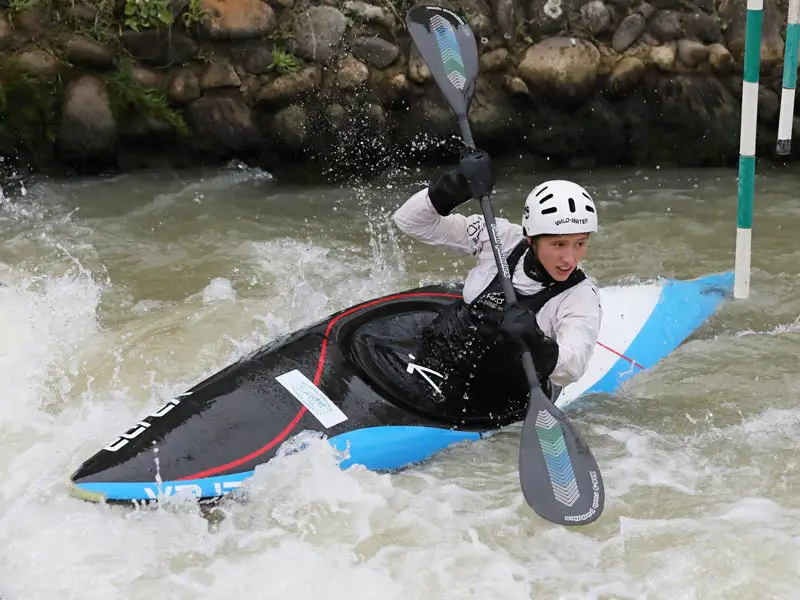
The Racing Kayak
If you are looking to race your kayak, then it will need to be as long as possible. This length can be as long as 36 feet, and the amount of speed will be dependent upon the number of paddlers the kayak is suited for. There will usually be a rudder involved to assist in directing, and are designed for sprints and marathons. Racing kayaks are light, narrow, and close to the water to maximize their speed.
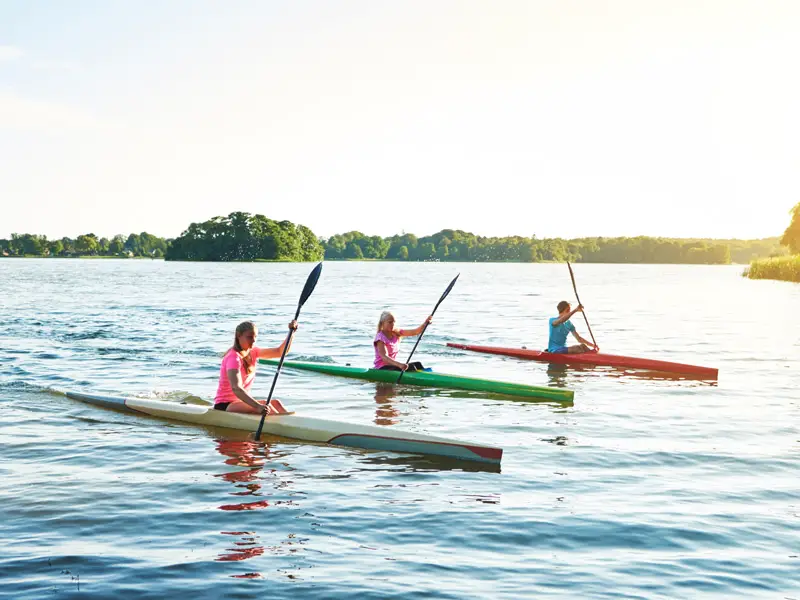
The Recreational Kayak
A recreational kayak will be at least 9 feet and is used for casual, recreational purposes and on water that is calm, such as lakes, canals, and smooth rivers. You will be very comfortable in a recreational kayak, and you will be able to control it at all times without fear of capsizing easily. Most people start off learning in a recreational kayak before trying different aspects of the sport.
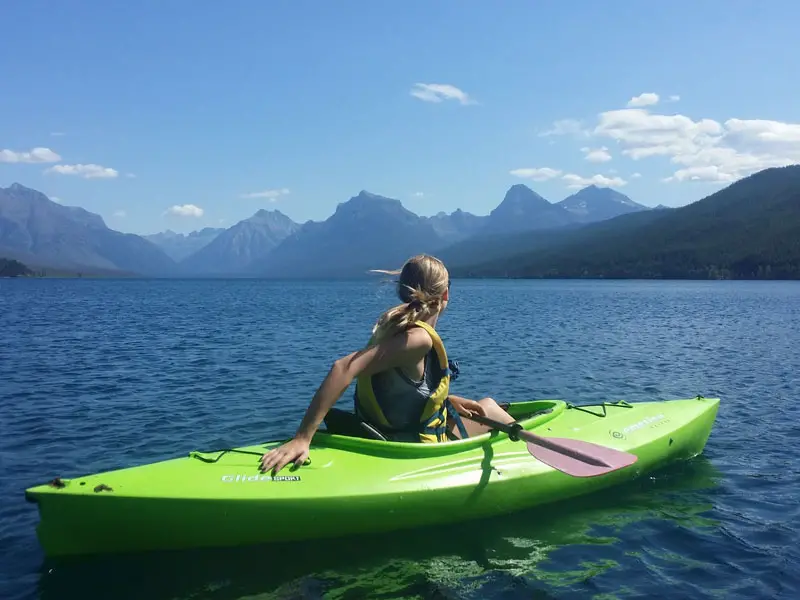
The Sit-On-Top Kayak
This kayak is designed for the paddler to be sitting on top in the middle. If you are a beginner kayaker, then this type is perfect to start off on. You will find them in calm water, and can be used for diving and fishing. Sit-on-top kayaks are also virtually unsinkable as they are completely sealed vessels and cannot lose their buoyancy due to the ingress of water.
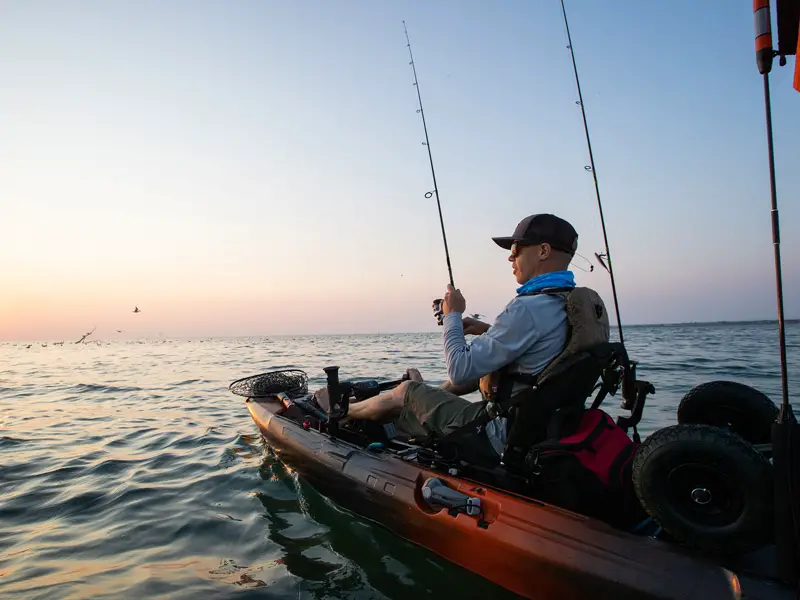
Is It Easier To Kayak Or Canoe
If you are trying to decide if a kayak or canoe is the better option for you, then you need to ask yourself, is it easier to kayak or canoe? With all things considered, most people find it easier to kayak than to canoe. However, you should still try canoeing and kayaking as they are both easy sports to learn.
Kayak Or Canoe Which Is Better?
It is not easy to decide if a kayak or canoe is better than the other because it depends on so many factors, such as your reason for your water adventures and what you hope to achieve.
If you are planning to paddle the boat by yourself or are looking to cover longer distances, then a kayak may be better for you. Although, if you want to carry lots of gear and paddle as a team, then a canoe may be more suitable.
Canoe vs Kayak Stability
The stability of the canoe and kayak stems from the water conditions. When the water is calm, the stable option will be the canoe due to its wider design on the bottom. With rough water, the design of the kayak makes it more stable and allows the paddler to lean and worry less about flipping. Both kayaks and canoes can capsize; however, it isn’t as easy to flip one as you may first expect.
Read more about kayak stability.
Read more about canoe stability.
Canoe vs Kayak – The Pros and Cons:
Canoe Pros:
- Easier to load and unload, which is a benefit when portaging.
- Passengers can enter and exit easily.
- The canoe width makes them more stable.
- Your view is a lot better as you are in a higher position.
- You can load more supplies and cargo into a canoe.
Canoe Cons:
- Canoes weigh more than kayaks, making transport more difficult.
- There is a lot less maneuverability with a canoe, which then calls for additional work for turning.
- Their design is not as efficient and often requires multiple paddlers.
- The canoe’s cockpit is open and exposes the passenger to rain and splashing water.
Kayak Pros:
- The kayak design is efficient and can be paddled by one person.
- Fully waterproof bulkheads for safe storage of cargo
- Easily re-rightable if capsizing occurs
- Kayaks have a lightweight design, making them easier to transport.
- The cockpit of a sit-in kayak is closed, which keeps a paddler dry and protected inside.
- Kayaks are easier to turn and maneuver.
Kayak Cons:
- Kayaks are not as stable as the canoe and, thus, easier to capsize.
- They are more difficult to enter and exit compared to a canoe.
- They can carry less gear than a canoe.
In Summary: The Difference Between A Kayak And Canoe
Knowing what’s the difference between a kayak and a canoe is important when you want to have a truly enjoyable time on the water. Plus, the difference in what you use will also depend on what you plan on using them for. So make sure that you are aware of the differences before you make your decision.
Watch the video below to see the reasons experts give as to why you should choose either a kayak or canoe.
